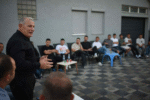For the first time since the onset of the war in Ukraine, Russia is conducting maneuvers involving tactical nuclear weapons. Does it make strategic sense for Moscow to deploy such weapons?
Military Exercises Near Ukraine’s Border
Russia has initiated military exercises involving tactical nuclear weapons, as announced earlier this May. The initial phase of the exercise, conducted in the southern part of the country near the Ukrainian border, involves the preparation and use of non-strategic nuclear weapons, according to the Russian Ministry of Defense. These drills are the first of their kind since the start of the conflict in Ukraine. The exercises are being carried out by units of the “Southern Military District” with the participation of air and naval forces.
The objective is to “increase the readiness of non-strategic nuclear forces.” Russian air defense extends beyond its territory, covering the Crimean Peninsula annexed by Russia in 2014, as well as the Kherson, Donetsk, Luhansk, and Zaporizhzhia regions, which were partially occupied in 2022 and subsequently declared part of Russia after staged referendums.
Western Criticism of Moscow’s Nuclear Threats
Western representatives have criticized Moscow’s leadership for its nuclear threats. While President Putin has not openly threatened a nuclear strike, he has warned the West of the potential for nuclear war in the event of a direct confrontation with Russia. Former Russian President and current Deputy Chairman of the National Security Council, Dmitry Medvedev, has repeatedly threatened the use of nuclear weapons. On May 6, he made a similar statement, linking the decision to conduct tactical nuclear exercises with the Western debate on the permissibility of sending ground troops to Ukraine.
Kremlin spokesperson Dmitry Peskov also connected the nuclear maneuvers to statements by Western politicians about the possible deployment of ground troops in Ukraine, particularly referencing French President Emmanuel Macron. Peskov described this as a “new round of escalation.”
What Are Tactical Nuclear Weapons?
Tactical nuclear weapons differ from strategic ones. They have a shorter range and less destructive power, typically involving artillery, ballistic missiles, and other combat rockets. These weapons can be launched from both conventional and nuclear-armed systems.
Ground-based missile systems with a range of up to 500 km, as well as sea or air-based missiles with a range of up to 600 km, are considered tactical nuclear weapons. However, the classification lacks clear boundaries.
Experts Say Use in Ukraine “Makes No Sense”
Experts consulted by Deutsche Welle believe that the use of nuclear weapons in Ukraine is unlikely and nonsensical. “Militarily, the use of nuclear weapons by Russia in Ukraine makes no sense in such circumstances,” says Pavel Podvig, a research director at the United Nations Institute for Disarmament Research. This perspective has not changed, he asserts.
Russia will not conduct an actual attack in such a maneuver but will practice the procedure for using the weapons, Podvig explains. “Normally, non-strategic warheads are stored separately from the missiles and aircraft from which they could be launched.” Podvig hopes this maneuver is conducted with simulated military equipment for safety reasons.
Nikolai Sokov, a researcher at the Vienna Center for Disarmament and Non-Proliferation (VCDNP), believes that there have “never” been plans to use nuclear weapons in Ukraine. Such plans did not exist even in the fall of 2022, when Russian forces withdrew from the Kharkiv and Kherson regions. Although there were reports in American media suggesting this, Sokov emphasizes that the Russian military has since gained superiority over the Ukrainian forces and is advancing in several eastern regions. Kyiv even expects an expansion of Russian attacks.
Nuclear Exercises as a “Warning to the West”
Russia’s threats have another context. “Nuclear escalation” is a phrase that has frightened the West since the beginning of the war in Ukraine. Some Western politicians and experts see this as the main reason why arms supplies to Ukraine have been slow and limited.
Mathieu Boulègue from the American Wilson Center believes that Moscow relies on this fear. He does not think the maneuver is solely linked to “France’s stance,” referring to Macron’s recent comments about not ruling out the deployment of ground troops, but rather is part of the Kremlin’s ongoing “intimidation and saber-rattling” to break Western resolve in supporting Ukraine.
Experts agree that Russia’s military maneuvers are more of a “signal and warning directed at the West.” This political signal contains nothing positive, yet efforts must be made to understand it clearly, emphasizes expert Pavel Podvig.







